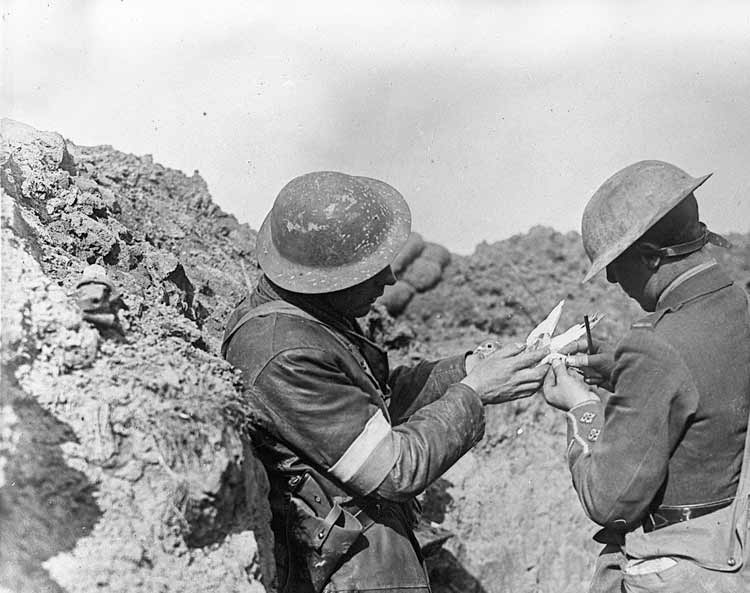Pigeons Part In The War
(Dated December 2 1918)

Bird which carried message for the Queen.
Saving Life at Sea.
The pigeon is playing its part in the war. There are several thousand pigeons today in the Naval Pigeon Service, of which more than half have been lent to the Navy by private owners in the United Kingdom, among them the King and Queen.
When their Majesties were visiting a naval base recently they saw one of their own birds. The Queen wrote a message and despatched it to Sandringham by the pigeon.
The duties performed by this branch of the naval service are very important. The pigeon has repeatedly been the means of saving lives at sea. British submarines, trawlers, drifters and other craft in home waters, and even aircraft, have often benefited from the activities of the pigeon service.
Nearly 1,000 messages carried by pigeons have passed through the headquarters of the Naval Pigeon Service, and, as might be expected, they suggest all kinds of pictures of warfare. Here are one or two instances:
Officer's last message.
A French naval officer in a seaplane was driven down by hostile aircraft and had to seek the sea within range of some enemy coastal batteries.
The shells were soon falling around him, and he realised that the end was near. He carried a pigeon and sent back his last message by the bird; "They have got the range. All is over. Vive la France."
A British seaplane sent the following message in duplicate by two pigeons at 7.24am one day. "Am down off North Goodwin light vessel. Rough sea." Both pigeons brought the message in at 8.0am and by 8.30am a vessel had been sent to the pilot's assistance.
Upon one occasion the crew of a flying-boat found themselves in difficulties at sea and despatched an appeal for help by means of a pigeon. The weather was bad; there was a strong head-wind against which the bird had to battle. He fought his way homeward until he had crossed the coastline; but his exertions proved too much for him and in the end he fell dead within a few miles of home. The message was delivered, however, and the crew of the flying boat were saved.
Pigeon saves a crew.
When the skipper of the trawler Nelson was attacked by a U-boat he defied the German and fought his ship to the last. Lying mortally wounded on the deck the heroic skipper wrote out a short appeal for help and sent if off by pigeon. This was his last act before he died. The pigeon carried it to a vessel in the vicinity and help was sent to the gallant trawler crew. It arrived in time to save the rest of them from death.
Most of the messages sent by pigeons come through to their destination without mishap. As a matter of fact, 95% of these messages have been delivered, a splendid record when one remembers the dangers to which the pigeons are subjected.
Apart from adverse winds on a long flight, there are hawks ready to attack a tired pigeon, and ignorant "sportsmen" who shoot homing birds under the impression they are firing at wood pigeons. In this connection, it is well to remind such persons that the destruction of homing pigeons is an offence under the Defence of the Realm Act.
Courtesy, The Australian Racing Pigeon, Vol. II, No.6. 2.12.1918
To be continued....
Historian Note: This is not Western Australian, but it was found among the records and is surely worthy of mention. It is also worth mentioning that Australian pigeons, including Western Australian pigeons, were used extensively throughout the islands in the defence of Australia, during World War II, and pigeons continue to be used up to present day in all theatre of war. As has often been said in reference to modern communications, and the methods used to block the electronic airways, "You simply cannot 'jam' a pigeon!"
